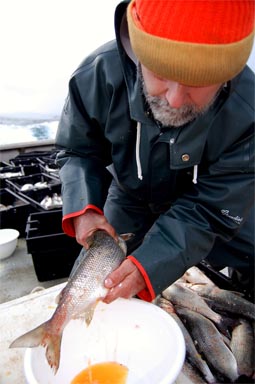Lake Herring: Bringing a native fish back to Lake Huron
A movement is underway to reintroduce lake herring (cisco) back into Lake Huron as researchers consider best practices in developing a hatchery to support strong genetic lines.
Lake herring (cisco) were once an abundant fish in the Great Lakes that served as a forage fish and provided a commercial fishery. In recent years, the most abundant populations of lake
herring exist only in Lake Superior and northern Lake Huron. When the lake herring disappeared, the predominant forage fish that took its place was the non-native
alewife. The alewife supported the salmon fishery in the Great Lakes but had negative qualities such as high levels of thiaminase, which interferes with reproduction of trout and salmon. The alewife is a
predator  on many of our native larval fish and thus hinders recruitment in fish such as lake trout and walleye.
on many of our native larval fish and thus hinders recruitment in fish such as lake trout and walleye.
The lake herring, which is a native species, does not share the negative attributes of the alewife. In recent years, the alewife population has declined in Lake Huron, leading to a window where the native lake herring might be reintroduced and many stakeholders have promoted the reintroduction of the lake herring. Some issues that need to be resolved before a reintroduction are the development of hatchery facilities that can produce large numbers of lake herring and determining what genetic lines should be used in this rehabilitation effort.
At a recent Lake Huron Citizens Fishery Advisory Committee meeting, Michigan Sea Grant Extension Educator, Ron Kinnunen, made a presentation on “Cisco Egg Take and Fertilization for Culture at Distant Locations and an Overview of the Various Morphotypes Available from Lake Superior.” The committee reviewed the past work on spawning both lake herring and lake whitefish off commercial fishing vessels. By using live, ripe fish that are immediately taken from the water, the ultimate production of viable offspring has a higher success rate. Research was also reviewed by a team led by Dan Yule, of the United States Geological Survey, on morphometric variation among spawning cisco aggregations in the upper Great Lakes. Yule compared three morphotypes or body forms of cisco found today and compared them to historical work published by Walter Koelz, in 1929, on the three body forms that he described. By doing this research, findings support that the open water Lake Superior would be the best match to reintroduce cisco into the open waters of Lake Huron.
Kim Scribner from the Department of Fisheries and Wildlife at Michigan State University made a presentation at the Lake Huron Citizens Fishery Advisory Committee meeting on “Genetic Considerations when Selecting a Broodstock for Cisco Restoration in Lake Huron.” Dr. Scribner discussed genetic principles and data that must be applied and considered when discussing re-establishment of cisco in Lake Huron. Hatchery production can result in a loss of genetic variability because eggs and milt often are taken from a relatively small number of individuals that may not be a good representation of the gene pool of the entire population.
In recent years, the Michigan Department of Natural Resources has attempted to reintroduce cisco into the mid-region of Lake Huron using fish spawned from the St. Marys River. This has been a small-scale project and many feel that to have greater success a much larger scale operation will be needed.



 Print
Print Email
Email




